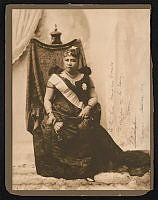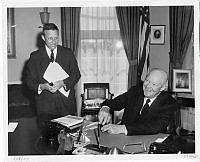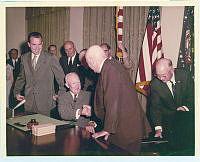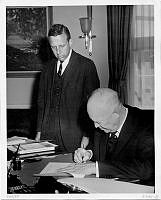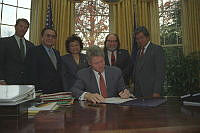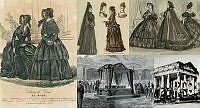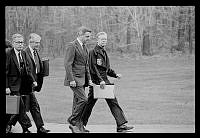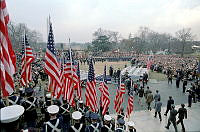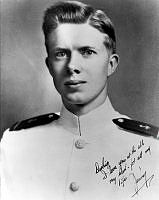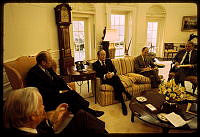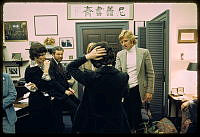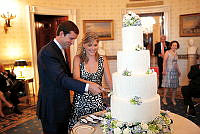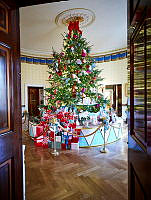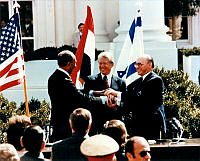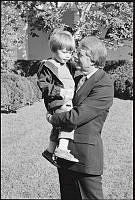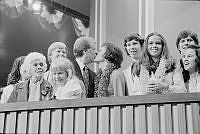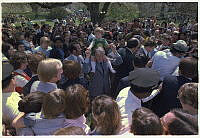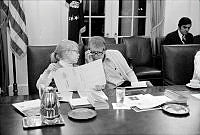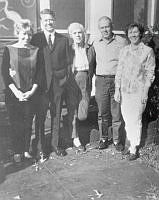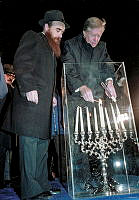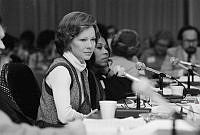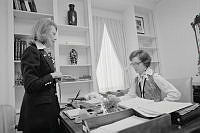A Glimpse of Calvin Coolidge's White House
The Photographs of Ralph Waldo Magee
Copyright © Fall 2000 White House Historical Association. All rights reserved under international copyright conventions. No part of this article may be reproduced or utilized in any form or by any means, electronic or mechanical, including photocopying, recording, or by any information storage and retrieval system, without permission in writing from the publisher. Requests for reprint permissions should be addressed to books@whha.org
In addition to important holdings in historical memorabilia, art, and furnishings, the White House collection also has an archives of documentary material. Notable are the historic photographic images. Original photographs, stereographs, glass and film negatives, and color transparencies, as well as copies of photographs from other repositories, illustrate the history of the White House from the 1840s to the present. Images documenting exterior and interior views, renovations and additions, excavations, architectural elements, grounds and greenhouses, objects from the permanent collection, social events, presidential families, and employees have proved invaluable resources for scholars of White House history. In an effort to add to the knowledge of the White House, the Office of the Curator continues to seek historic photographs for the collection.
In 1992, Harriet Magee Fello donated to the White House a remarkable collection of papers and photographs that belonged to her father, Ralph Waldo Magee (1880-1950). Magee, a federal employee for 49 years, worked at the White House in the office of the social secretary from January 1920 until his retirement in June 1948. Although an amateur photographer, he had an eye for the art and a unique opportunity during his employment to photograph the White House—the public areas as well as the family quarters.
Harriet Fello’s gift of 237 silver gelatin photographs, 45 glass negative plates, and 33 film negatives date as early as the 1900 inauguration of President William McKinley and as late as Magee’s 1948 retirement.1 Thirty-one photographic prints appear on scrapbook pages and feature views of Washington, D.C., during President William H. Taft’s inauguration, the Wright brothers’ plane, and other personal photographs from the early 1900s. Many of the White House photographs in this collection, however, were taken by Magee to accompany a manuscript he wrote in 1928 but never published.

A portrait of President Calvin Coolidge.
White House Historical Association (White House Collection)Several handwritten and typewritten drafts of Magee’s 1928 proposed book are included with his papers.2 Compiled during the last year of the Coolidge presidency, the text begins with a poem about the White House and a brief historical overview. A section entitled “A Trip Through the House” describes rooms found in the public areas (the ground floor and the state floor), the family quarters (the second floor and the third floor), and in the Executive Office Building (today’s West Wing). Magee’s text also provides information about White House staff positions, the 1927-28 social season of receptions and state dinners, musicals, garden parties, receptions for schoolgirls, the Easter Egg Roll, Marine Band concerts, and the procedures followed for those events. The research notes, bibliographies, and newspaper clippings he used are intact.
Ralph Waldo Magee was born in Howard, Pennsylvania, in 1880. His father, a Civil War veteran and teacher, eventually moved the family to Washington, D.C. In May 1899, at the age of 19, Magee began his government career as a messenger for the Department of the Navy at the Navy Yard in Washington, D.C. He transferred to the Department of Agriculture in 1903, where he worked as a copyist and later as a clerk. In February 1914 he was detailed to the Executive Office of the President and reported directly to the secretary to President Woodrow Wilson, Joseph P. Tumulty. Transferred to the White House again in 1915, by 1920 he was permanently assigned to the office of the social secretary, where he would become administrative officer of social correspondence.

Steinway & Sons presented their 100,000th Piano to the White House in 1903. The special Concert Grand Piano is seen here placed on a stage at the north end of the East Room for a musicale.
White HouseThe social secretary’s office was responsible for answering routine letters and requests addressed jointly to the president and first lady or to the first lady herself. As Magee described it, “Answers to most of these letters must of necessity be disappointing, and the Social Secretary’s desk is some times referred to as ‘The Desk of Many Regrets.’” Among Magee’s papers are examples of form letters from seven different administrations beginning with Grover Cleveland.
In addition to their documentary value, Magee’s photographs also display technical skill and his love for the White House. He was a self-taught photographer who developed his own film and printed his own work. According to his daughter, one of his favorite cameras was a small “Brownie.” He belonged to a Washington camera club and was presented with at least one award for his work by the Wyoming Valley Camera Club in Pennsylvania, May 23, 1908. Copies of letters from First Ladies Grace Coolidge and Eleanor Roosevelt and from Florence Harding’s private secretary, Laura Harlan, are included with the papers and describe their support and admiration for his photography.
A few of Magee’s photographs were published during his lifetime. An image of the Lincoln bed, for example, was selected to accompany an article written by Mrs. Coolidge describing a coverlet that she had crocheted for the bed.3 At Mrs. Coolidge’s suggestion, Magee’s photograph of the North Portico door decorated with a Christmas wreath was the basis for an illustration that appeared with an article she wrote about the meaning of the holiday.4 President and Mrs. Franklin D. Roosevelt also selected his photograph of the East Garden for their 1933 Christmas card.

A portrait of First Lady Grace Coolidge.
White House Historical Association (White House Collection)The Coolidge-era photographs reveal a White House in many ways still reflective of the Theodore Roosevelt renovation of 1902, but one that would again undergo changes. In 1927, a major renovation of the roof and attic area resulted in a third floor for additional guest bedrooms, service rooms, and a new solarium. President Coolidge’s administration also marked the beginning of a historical consciousness about furnishings and an effort to have the public rooms suggest the early-19th-century appearance of the White House, when it was new. A joint resolution passed by Congress at Mrs. Coolidge’s request authorized the acceptance of gifts that she hoped people would be induced to make. Beginning in 1927, Mrs. Coolidge worked with an advisory committee of experts to refurbish the Green Room in a historical way. Although the gifts were not as numerous as Mrs. Coolidge had hoped for, it was a beginning, and her vision of fine period antiques for the White House would become a reality in later administrations. To this day, the federal style tends to dominate.5
It is rare to find photographs of the family quarters and staff areas from this early period. Prior to the 1930s, permission to photograph these rooms had been granted on only a few occasions. Images by Frances Benjamin Johnston from the 1890s and those taken at the time of the 1902 renovation are notable exceptions. Only with Mrs. Coolidge’s written consent was Magee able to take these photographs.
Gallery
-

Mrs. Coolidge’s Bedroom was more her personal sitting room, where she often attended to correspondence. She selected the Lincoln bed for her room and crocheted a coverlet for it hoping to start a tradition in which first ladies would leave a memento for the White House.
White House Collection -

Magee described the Red Room as a “parlor where the ladies of the house received callers.” While the Red Room maintained its 1902 decor during the Coolidge years, the Aubusson-style rug was made by Tiffany Studios, 1927-28. Gilbert Stuart’s 1797 replica of his Lansdowne portrait of George Washington, seen at left, was placed in this room in 1903. It was returned to the East Room in 1929 by Mrs. Herbert Hoover. On the east wall, between the doorways leading to the Blue Room, hung the 1878 portrait of John Adams by Edgar Parker, after a likeness by Gilbert Stuart. According to Chief Usher Irwin “Ike” Hoover, President Coolidge objected to the bald spot that appeared at the top of Adams’s head and asked for hair to be painted on it. The chief usher chose to have the varnish layer dulled instead.
White House Collection -

Steinway & Sons presented their 100,000th Piano to the White House in 1903. The special Concert Grand Piano is seen here placed on a stage at the north end of the East Room for a musicale. The piano was overlaid with gold and decorated with patriotic imagery. An allegorical scene, America Receiving the Nine Muses, was painted on the inside lid by Thomas Dewing.
White House -

The East Room set in preparation for a musicale performance. Two upholstered armchairs stand front and center, for the president and first lady, while lighter, gilt bentwood chairs await the guests.
The White House -

In the State Dining Room, the mahogany table is set for President Coolidge’s luncheon for German and Irish fliers, May 2, 1928. Originally acquired for the Family Dining Room in the 1890s, the table was found in the former or “old” kitchen by Edith Wilson and placed in the State Dining Room for occasions when a banquet table was not required. A portrait of Calvin Coolidge appears over the fireplace.
White House Collection -

Adetail of the Place Setting for the attorney general shows a service plate from the Woodrow Wilson state service, gilded silver flatware, and a “Russian” pattern goblet and tumbler from the Benjamin Harrison service.
White House Collection -

The position of “ceremonial officer” was created in 1925 to supervise and arrange the official social functions, leaving personal engagements and correspondence to the social secretary. During the social season, the ceremonial offi cer, detailed from the State Department, worked from a desk in the East Sitting Hall on the second floor, easily accessible for consultations with the first lady. Before the days of telephones with multiple lines, three phones, seen on the desk at right, were required to provide an outside line, a direct line to the social secretary’s office, and a direct line to the Usher’s Room.
White House Collection -

When the roof was removed in 1927, and the attic area enlarged as a third floor, a solarium was built over the South Portico. Mrs. Coolidge named it her "Sky Parlor," perhaps making use of an old-time Virginia term for a sunny attic room. "It was understood that when I was there I was not to be disturbed," she wrote, "unless for some urgent reason. A cot bed, a writing table, some porch furniture, a phonograph, and a portable radio provided comfort and entertainment. I was there with some friends the day that Graf Zeppelin passed over Washington. On the table stood the radio, with no tangible connection with the outside world, bringing us music from a distant station, while up in the air floated a huge, silvery man-made conveyance, bringing people across the wide ocean."6
White House Collection







